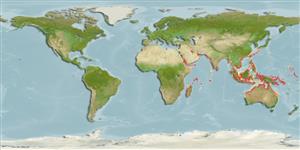Environment: milieu / climate zone / depth range / distribution range
Ecology
Marine; demersal; depth range 20 - 27 m (Ref. 11790). Tropical
Indo-West Pacific: Persian Gulf east to India; throughout the Malay Peninsula to the Philippines and Indonesia.
Size / Weight / Age
Maturity: Lm ? range ? - ? cm
Max length : 35.0 cm SL male/unsexed; (Ref. 9774); common length : 20.0 cm SL male/unsexed; (Ref. 9774)
Dorsal spines (total): 0; Dorsal soft rays (total): 72 - 74; Anal spines: 0; Anal soft rays: 58 - 59. Body brownish, a small dark blotch at junction of straight and curved parts of lateral line. Body deep ovoid, its depth 1.8 to 2 times in SL. Head length 3.1 to 3.3 times in SL. Upper-eye diameter 5.3 to 5.9 times in head length. Maxilla extending to below posterior margin of lower eye. Upper-jaw length 2.3 to 2.4 times in head length. Teeth in upper jaw small and close-set laterally, and enlarged anteriorly. Teeth in lower jaw stronger and more widely spaced than those of upper jaw. Pectoral fin on ocular side with 12-13 soft rays (Ref 9774).
Found on the muddy and sandy trawling grounds of the continental shelf. Feeds on benthic organisms. Sold mostly fresh in markets.
Life cycle and mating behavior
Maturities | Reproduction | Spawnings | Egg(s) | Fecundities | Larvae
Distinct pairing (Ref. 205).
Nielsen, J.G., 1984. Bothidae. In W. Fischer and G. Bianchi (eds.) FAO species identification sheets for fishery purposes. Western Indian Ocean fishing area 51. Vol. 1. FAO, Rome. pag. var. (Ref. 3322)
IUCN Red List Status (Ref. 130435)
Threat to humans
Harmless
Human uses
Fisheries: commercial
Tools
Special reports
Download XML
Internet sources
Estimates based on models
Preferred temperature (Ref.
123201): 24.5 - 29.1, mean 28 °C (based on 98 cells).
Phylogenetic diversity index (Ref.
82804): PD
50 = 0.5000 [Uniqueness, from 0.5 = low to 2.0 = high].
Bayesian length-weight: a=0.00741 (0.00343 - 0.01604), b=3.17 (3.00 - 3.34), in cm total length, based on LWR estimates for this Genus-body shape (Ref.
93245).
Trophic level (Ref.
69278): 3.4 ±0.42 se; based on food items.
Resilience (Ref.
120179): Medium, minimum population doubling time 1.4 - 4.4 years (Preliminary K or Fecundity.).
Fishing Vulnerability (Ref.
59153): Low to moderate vulnerability (33 of 100).
